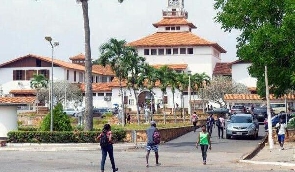THE NEW FAMILY OF GHANA CEDI NOTES AND COINS AND GHANA PESEWA COINS
PRESENTATION TO THE PUBLIC
REMARKS BY DR. PAUL A. ACQUAH,
GOVENOR, BANK OF GHANA
ACCRA, MAY 3, 2007
1. Members of the Board, Managing Directors of Banks, Ladies and Gentlemen, let me welcome you to this short ceremony which we consider landmark in the re-denomination exercise. The introduction of the Ghana cedi notes and coins and the Ghana pesewa coins is a monetary measure to underpin the regime of stability observed for some time now.
2. In a sense this exercise should not be seen as just another currency exchange exercise but rather an important means of promoting efficiency in the way business is done in Ghana. The new currency will allow the domestic currency (the cedi) to assume its role as the means of exchange and store of value for all, both within and outside the banking system in a stable low inflation environment.
Guidelines 3. The Bank of Ghana has issued guidelines on the pricing of goods and services, exchange quotations, banking transactions and accounting systems to facilitate the smooth roll out of the re-denomination exercise.
Unveiling the New Currency 4. Ladies and Gentlemen, today’s event is a critical landmark of the public education programme on the currency re-denomination scheduled to commence in July 2007. This aspect of the education is dubbed “Know Your Notes & Coins and Security Features”. It will be pursued through visual presentations on television stations, posters as well as the Direct Community Contacts to allow for easier identification of the Ghana Cedi Notes and Ghana pesewa coins.
5. You would recall that since the announcement of the re-denomination exercise a public education campaign has been implemented aimed at sensitizing the general public. This has been followed by a countrywide distribution of advertising materials (flyers, posters, leaflets), as well as radio and TV broadcasts in different languages.
6. Bank of Ghana staff have participated in programmes such as Adult Education on the National Television Station and other similar programmes on other television stations in the country. The bank has also launched a special website on re-denomination and organized seminars. Under the Direct Community Contact program, the Information Services Department (ISD) and the National Commission for Civic Education (NCCE) have been undertaking direct contacts with the communities in all the 138 districts of the country to reach those in the rural areas.
7. Reports from these institutions indicate that significant progress has been made in carrying out the educational campaign. The N.C.C.E. has so far contacted all the ten communities selected from each district in the country with 20 visits each. The campaign strategy has involved community fora, talks with the opinion leaders including the chiefs, visits to the churches, schools, mosque and market through cinema vans and mobile vans and has worked according to plan. In most of the places visited, the people were eager to see specimens of the new currency and pamphlets which therefore adds to the importance of this day’s launch.
Note and Coin Design 8. The new family of notes and series of coins to be unveiled today have been designed to pay tribute to some key personalities for their contribution to the social, political and economic development of our great nation. They also reflect the historical significance of some of the national monuments and cultural values in our country’s development.
9. The pictorial concept/image on the front of all the notes, and the same design concept on the reverse of all the coins were chosen for the new notes and coins. These together constitute a unique family of notes and coins.
The Notes 10. The design of the notes involved the selection of dominant colours for each note, as well as some prominent national monuments and concepts for the back (reverse) of the notes. They all incorporate very robust security features to allow for easy and safe recognition and transactions. • The fifty Ghana cedi (GH¢50) depicts the Christianborg Castle, the seat of government at the back (reverse); and the twenty Ghana cedi (GH¢20) shows the Supreme Court Building representing the rule of law also at the reverse. The two together capture the importance of good governance in the Ghanaian society. • The ten Ghana cedi (GH¢10) shows the Headquarters of the Bank of Ghana at the back (reverse), which acknowledges the Bank as the sole issuer of currency as well as the significant role of the financial system in the overall development of the economy. • The five Ghana cedi (GH¢5) has the University of Ghana (the Premier University) at the back, representing the role of education in the social, political and economic development of our nation; • While the one Ghana cedi (GH¢1) has the Akosombo Dam at the back, recognizing its key role in generating electricity over the years for industrial and domestic use, which has been the back-bone of economic activity.
The Coins 11. The Ghana Coat of Arms is shown at the back (reverse) of all the new series of coins. This captures among other things the mineral and agricultural wealth of this country; the continuing link between Ghana and the commonwealth; the lone star of African freedom; and the national aspirations.
The front (that is the obverse) of each coin is a different image symbolizing some aspect of the Ghanaian heritage and tradition.
• The one Ghana cedi (GH¢1) has the image of the scale of justice which characterizes equity and fairness in the delivery of Justice and re-enforces the rule of law in Ghana. • The fifty Ghana pesewas (50Gp) has an image of a market woman, which symbolizes the significance of women in business and their contribution in building the Ghanaian economy and the society as a whole. • The twenty Ghana pesewas (Gp20) depicts the cocoa pod which represents the agricultural wealth of our country and economic importance of cocoa over the years. • The ten Ghana pesewas (Gp10) is devoted to a book, which also emphasizes the role education plays in a democratic society. • The five Ghana pesewas (Gp5) shows a horn blower, representing traditional mode of communication in Ghana; and finally • The one Ghana pesewa (Gp1) has an image of the Adomi Bridge, indicating the significance of infrastructure and freedom of movement of goods and people in a united Ghana.
In addition to these images, user requirements including fitting the wallet, ease of banknote automation and features for the visually impaired were incorporated in the design.
Security and Durability 12. The notes have strong safeguards with regards to security and durability. These include among others: • A watermark as an integral part of the notes. This carries an image of Tetteh Quarshie, the man who first brought cocoa seed into Ghana in 1879, from Fernando Po, off the West African Coast. The image of Tetteh Quarshie and Cocoa Pod appear in subtle areas of light and shade when held up to the light; • See through feature which allows the denomination of the banknote to be seen clearly when held up to light; • A latent image, which is not obvious to the observer when viewed normally but at a 45 degree angle the image of the denomination appears; • A Security Thread which when viewed in reflective light, bars can be seen which change colour from red to green when tilted (for the 20 and 50 Ghana Cedis), or shiny silver bars can be seen (for 1, 5, and 10 Ghana Cedis). A solid line appears containing the text Ghana and the denomination when held up to the light; • Each denomination is printed in intaglio Gold which combines the unique characteristics and the benefits of intaglio printing with a metallic golden coloured ink; • An iridescent band that has a colour-shifting property which makes the colour appear shiny from one angle and matt from another angle; and • A Hologram in the 10, 20 and 50 Ghana Cedis which incorporates numerous smaller images in two distinct sets, that is ‘BG’ and denomination.
There will be a detailed presentation on “Know Your Security Features” as part of the public education programme.
13. On the durability, enhancements have been introduced to extend the lifespan of the notes. Similarly, the coins were minted from metals and nickels, which are environmentally friendly.
14. Ladies and Gentlemen, you will realize that up till now I have not described the front (obverse) of the new notes. The unique thing about this family of notes is that all of them have one portrait at the front, comprising distinguished Ghanaians in the history of the country. ? Dr. Kwame Nkrumah, was a member of the United Gold Coast Convention (U.G.C.C). He was later arrested and detained under the Emergency Regulation in 1948 following disturbances, which led to the killing of three World War II veterans. He later became the First Prime Minister (1957-1960) and the First President of Ghana (1960-1966); ? Mr. Ebenezer Ako Adjei was a founding member of the U.G.C.C. and also instrumental in introducing Dr. Kwame Nkrumah to the political scene in Ghana. He was also arrested and detained together with Nkrumah under the Emergency Regulation; ? Mr. Edward Akufo-Addo, a founding member of the U.G.C.C. and later chief justice and then President of Ghana in the Second Republic (1970-1972). He was also arrested and detained together under the Emergency Regulation in 1948; ? Dr. Joseph Boakye Danquah was a founding member of U.G.C.C. and the chief organizer of the U.G.C.C. He transformed it from a grassroots movement into a political party, which spearheaded the struggle of Ghana’s independence. As was the case with the other founding members, he was also arrested and detained; ? Mr. Emmanuel Odarkwei Obetsebi-Lamptey was a founding member of the U.G.C.C.; and finally ? Mr. William Ofori Atta, a founding member of the U.G.C.C. and later became a Minister of Education and then Minister for Foreign Affairs in the Second Republic of Ghana.
These six gallant men who spearheaded the struggle for Ghana’s independence took a historic picture in a single file, which has been re-composed into a single oval portrait to form the “Big Six”. This is the portrait on the front (obverse) of each of the notes. And, they are the ones who are being honoured today in this Jubilee year.
Also on the front of each of the notes is the Independence Arch; the symbol of political independence of Ghana.
15. On this note, I have the honour and pleasure to officially unveil the new family of the Ghana Cedi notes, the Ghana cedi coins and the Ghana Pesewa coins. This also begins the education campaign on “Know Your Notes & Coins and Security Features”. The media is challenged to take this opportunity to help familiarize all and sundry with the new notes and coins.
Thank you for your attention.
Business News of Friday, 4 May 2007
Source: BOG
New Ghana Cedi Notes & Coins Launched













